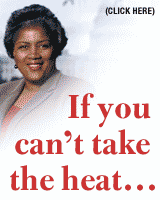
“I am convinced that America offers something
real for black people. It is not though, the romantic love of
integration — though, like romance, we may seek and sometimes
experience it.” – Derrick Bell, Silent Covenants (2004) My wife and I recently attended an open house
in Newark, New Jersey hosted by Keller Williams, a realty company
in a suburb of Newark. During
the open house, the realtor boasted that the home was situated
on an “excellent, safe and quiet block.”
After a long discussion and some reflection,
we called the realtor later that evening, explaining that we
were prepared to make an
offer on the home and asking to meet him at the property to discuss
the sale. After a very long pause, the realtor reminded me that
it was well after dark – it was almost 7:00 p.m., after all – and
that because he was without the protection of his “bodyguard,” he
refused to come to Newark. Instead, the realtor suggested that
we meet him at a nearby McDonald’s. I replied that we were not,
in fact, attempting to purchase a McDonald’s franchise, and that
his refusal to meet us in Newark was deeply problematic, particularly
because he deliberately misrepresented as “excellent” a neighborhood
that he was unwilling to drive into after dark.
The realtor forcefully reiterated his refusal to meet us in Newark,
and said that we could either meet him at McDonald's or at his
office in suburban Bergen County.
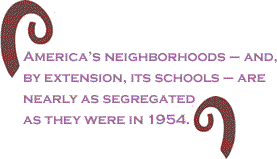
Unfortunately, the realtor’s behavior is not
just an isolated act, but is reflective of the type of behavior
that many whites
have effectively and consistently utilized to undermine attempts
to end racial segregation in this country.
Fifty years after the Supreme Court’s historic
decision in Brown
v. Board of Education, a case that overturned the “separate
but equal” doctrine, and one that is often cited as the milestone
in America’s march towards racial equality, America’s neighborhoods – and,
by extension, its schools – are nearly as segregated as they
were in 1954.
The unspoken subtext of Brown
 Commenting on the Supreme Court’s decision to require desegregation “with
all deliberate speed,” Robert L. Carter, former NAACP General Counsel
and one of the lawyers who argued Brown, asserted that it
was “clear that what the [“all deliberate speed”] formula required
was movement toward compliance on terms that the white South would
accept.” Carter explained that the Supreme Court failed to fully
appreciate the enormity of the segregation problem, and in showing
compassion to the white South by regulating desegregation at a
pace palatable to them, the Court both failed to develop a willingness
to comply with, and, in fact, encouraged white defiance of the
order to integrate. Commenting on the Supreme Court’s decision to require desegregation “with
all deliberate speed,” Robert L. Carter, former NAACP General Counsel
and one of the lawyers who argued Brown, asserted that it
was “clear that what the [“all deliberate speed”] formula required
was movement toward compliance on terms that the white South would
accept.” Carter explained that the Supreme Court failed to fully
appreciate the enormity of the segregation problem, and in showing
compassion to the white South by regulating desegregation at a
pace palatable to them, the Court both failed to develop a willingness
to comply with, and, in fact, encouraged white defiance of the
order to integrate.
And defy integration is precisely what many
whites did. To resist
the Supreme Court’s desegregation order in Brown, whites
closed public primary and secondary schools, and, in some cases,
literally blocked entrances to schools that remained open for Blacks.
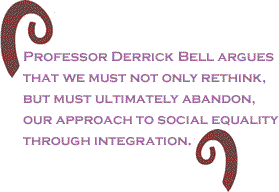
Not surprisingly, integration moved, to the extent it moved at
all, at a glacier-like pace in the years following Brown. Indeed,
by 1963, the 11 states of the old Confederacy had less than 2 percent
of their Black students attending school with white students.
Today, residential and educational segregation
rates equal those of the Jim Crow era to within two-tenths of
a percent in some neighborhoods,
resulting in what Professor Derrick Bell calls “social and economic
apartheid.”
If Albert Einstein was correct, and “insanity” is defined as conducting
the same experiment repeatedly and somehow expecting it to yield
a different result, then America may be insane as to its approach
to addressing racial segregation.
To stop the insanity, Professor Derrick Bell, a civil rights lawyer
who once believed that the Brown decision was the equivalent
of the “Holy Grail of racial justice,” argues that we must not
only rethink, but must ultimately abandon, our approach to social
equality through integration.
The suggestion that we abandon our integration
efforts is deeply offensive to some, and in fact, unthinkable
for others. But fifty
years after the Supreme Court overruled Plessy’s “separate
but equal doctrine,” integration has been unattainable. Even more
disheartening has been the unsuccessful endeavor to compel white
folks to share their neighborhoods and classrooms.
Professor Bell notes that, despite the onerous
burdens of segregation, many Black schools and neighborhoods
functioned well during segregation. Indeed,
many in the Black community who were at the center of the battle
for equal rights would have supported less than full integration.
Reflecting on his childhood in segregated Richmond, Virginia in
the 1950s, Randall Robinson in Defending the Spirit explained
that on his block “segregation compelled what would otherwise have
been a very unlikely black unity.”
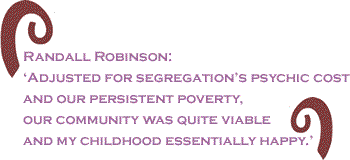
Around the corner from the Robinsons lived
the Petersons, “one
of Richmond’s most prominent black families.” Mr. Peterson was
a high school principal and his wife was a primary school teacher. Directly
across the street from the Robinsons lived Margaret and Grace,
who worked at home, as prostitutes. Next to Grace and Margaret
lived Mr. Owens, owner of “the Esso service station,” who put his “Christmas
tree up on his front porch in November and took it down in March.” From
Mr. Owens’ porch,” Robinson continues, “you could smell the industrial
strength fumes emanating from the nearby open windows of one of
our community’s most viable businesses, Shirley’s Beauty Parlor.”
Separated from white Richmond, Robinson remembers
that “we made
a world of our own with black service providers – teachers, doctors,
lawyers, preachers, hoteliers. Adjusted for segregation’s psychic
cost and our persistent poverty, our community was quite viable
and my childhood essentially happy.”
Given what is now known about the permanent
nature of racism in this country, and using the last fifty years
of unsuccessful integration
attempts as our guide, perhaps what is now needed, and what Bell
argues the Supreme Court in Brown should have done, is to enforce
the “equal” component of the “separate but equal” standard.
Bell urges that it is time to accept the obvious,
as did Booker T. Washington in 1895.
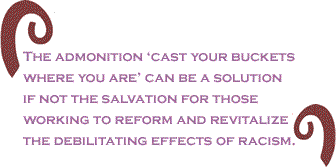
Booker T. Washington was praised by whites
and despised by Blacks for his accommodationist philosophy on
race, reflected in his 1895 “Atlanta
Compromise” speech, which encouraged Blacks to concede segregation
and to surrender basic citizenship rights in hopes that hostile
whites would respond with better schooling and employment for Blacks. Although
Washington’s speech no doubt deserved the condemnation it received
from the Black leaders of his day, he nevertheless articulated
a story that has significance for Blacks today.
Washington told the story of a ship that was
lost at sea for many days before finally seeing a rescue boat. The lost ship’s hysterical
crew signaled their desperate need for water, as they were dying
of thirst. In its response, the rescue boat told the lost ship
several times to “cast your buckets where you are.” The crew complied
and brought up buckets filled with fresh water from the Amazon
River into which they had inadvertently sailed.
About this parable, Bell notes that “whatever the wisdom of Washington’s
advice to a people whose dire physical plight was the result, not
of storms abroad, but of overwhelming racial hostility at home,
the admonition ‘cast your buckets where you are’ can be a solution
if not the salvation for those working to reform and revitalize
the debilitating effects of racism.”
To benefit from the resources among us, Bell
urges that Blacks must, among other things, supplement the continuing
struggle for
racial equality with creative forms of personal and collective
self-image, group organization, collection and distribution of
our shared resources, and strategic planning.
As crazy as it sounds, maybe accepting the
separate nature of our status in this country, and working towards
the “equal” component
of the “separate but equal” calculus, is where we should be headed. Blacks
have attempted to meet white folks at the McDonald’s of their choosing
for long enough.
Ryan Paul Haygood is an attorney. |

